Family and finance
Financial insights from the affluent Hispanic-Latino community
Putting clients first. It’s a commitment we take very seriously here at Merrill. And it requires a genuine and deep understanding of each and every client — not just as individuals, but as members of larger communities.
Today in the U.S., the Hispanic-Latino community is roughly 19% of the nation’s population1 (about 63.5 million people) — representing more than 20 countries around the world. And with each successive generation, the population steadily grows. From 2010 to 2019, Hispanic-Latinos have comprised more than half (52%) of the country’s population growth. It’s also a younger community — with Hispanic-Latinos making up one out of every four Americans under the age of 18.1
Over roughly the same time period, Hispanic-Latinos accounted for nearly three-quarters (73%) of net new growth in the U.S. labor force and experienced the fastest income and consumer spending growth among all Americans. In fact, if the U.S. Hispanic-Latino community were a standalone economy, it would be the fifth largest globally.2
For years we’ve sought to better understand the experiences, motivations and goals of the greater affluent Hispanic-Latino community. As we continue to track these important trends, however, we realize that much has changed over the ensuing years — from a once-in-a-lifetime pandemic to rampant inflation and rising interest rates. To that end, we conducted another survey in 2023 to identify emerging trends and uncover key successes as well as challenges and concerns in the community.
Explore the key findings:

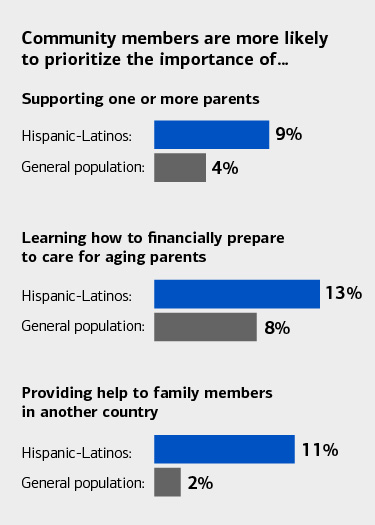
Hispanic-Latinos are more likely to view culture and community as important life aspects
Similarly, the Hispanic-Latino community is more likely to view their culture and community as important life aspects compared to the general population. And they are far more likely to feel a responsibility to help other community members succeed.
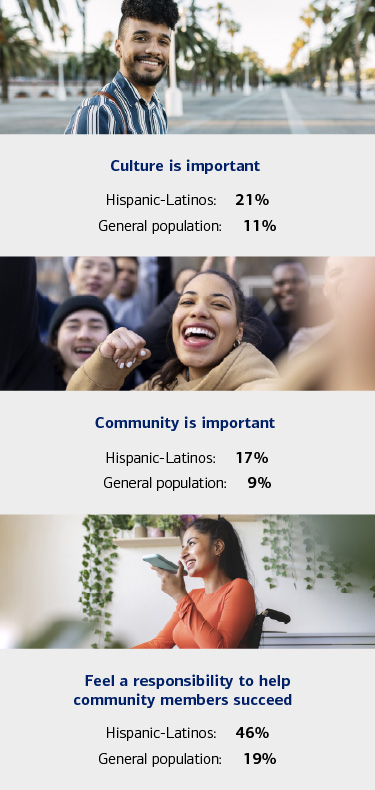
Individual and family wellbeing are top financial motivators
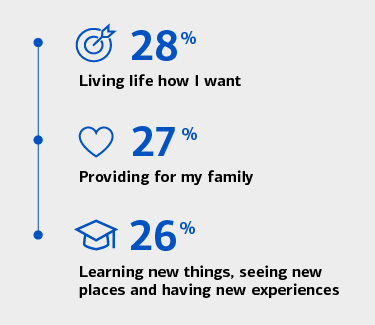
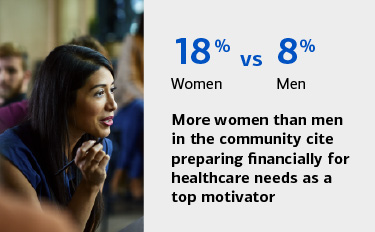

Optimism, financial attitudes and perceived barriers
Hispanic-Latinos are significantly more likely to feel better off about their economic outlook
Despite all the challenges of the past few years, members of the affluent Hispanic-Latino community are significantly more likely to feel better off in their economic outlook than the affluent general population and more optimistic about their financial future.
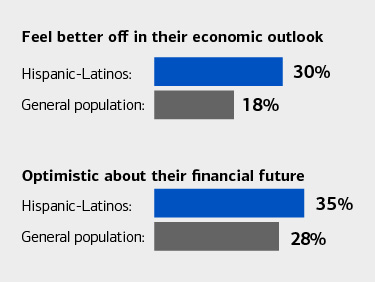
Hispanic-Latinos’ savings outpaced the general population
Over the past three years, affluent Hispanic-Latinos have outpaced the general population in saving more money than planned and donating more to causes they care about. Overall, this level of optimism and positive outcomes is a welcome sign. Perhaps, it is also a reflection of the increased effort so many have put into planning financially for their future, with 96% saying they have a financial plan — compared to 91% of the affluent general population.
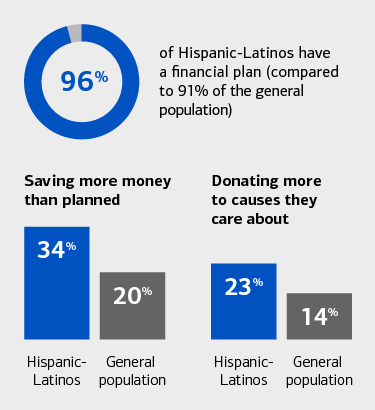
Yet older members of the community are less likely to be retired
Older affluent Hispanic-Latinos, ages 55 to 75, are far less likely to be retired than their counterparts in the general population. While individual reasons vary widely, for some it may be born of a simple desire to continue working in a job/field that they love — rather than driven by any overwhelming financial need.
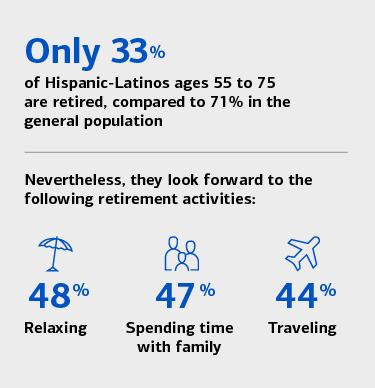
Hispanic-Latinos have more trust in financial institutions
Trust in financial institutions among the affluent Hispanic-Latino community also significantly exceeds that of the general population across all types of firms — including large national banks and full-service brokerage firms. And this disparity nearly doubles when it comes to online banks and investment tools/apps. While the Hispanic-Latino community’s preferences around financial products and guidance mirrors the general population in many respects, there are some differences as well. Hispanic-Latinos are more than twice as likely as the general population to say they use loans and credit as part of their overall wealth management strategy (44% vs. 19%), and twice as likely to say that those loans and credit help them acquire the things they need (46% vs. 23%).
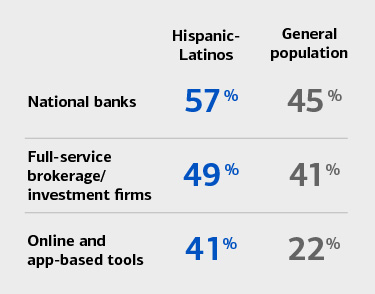
Hispanic-Latinos are less likely to rely on their financial advisor
While Hispanic-Latinos are just as likely to have a financial advisor as the general population, they are less likely to rely on that advisor for investment decisions. And for those that do not have an advisor, the key reasons are not knowing how to find one and not being able to find an advisor who understands their community and culture.
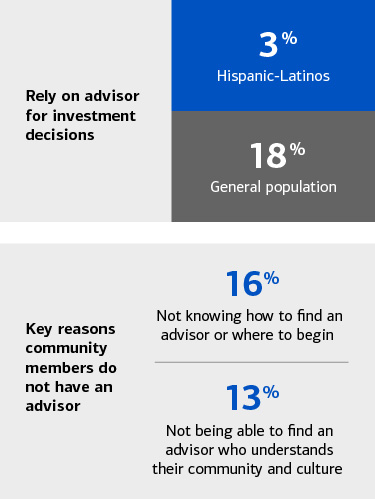
There are some financial barriers, stressors and concerns
While there is a great deal of positive financial momentum across the community, there remains some barriers, stressors and concerns.
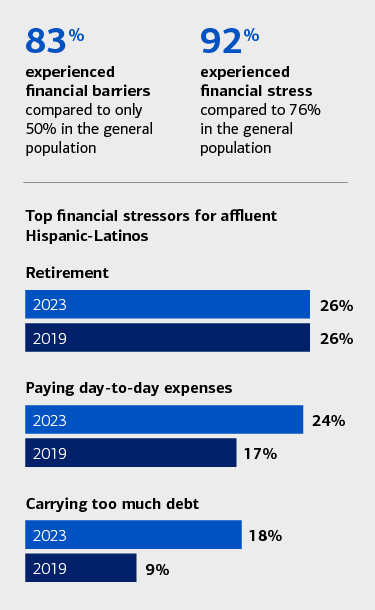
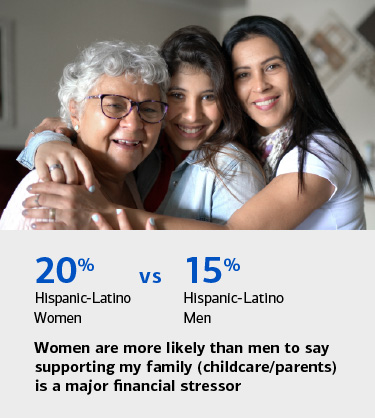
The underlying reasons for this are many and varied — but include paying back existing loans, gaining access to new loans and paying off medical bills, which nearly doubled as a stressor from 2019 to 2023 (climbing from 9% to 16%).
From a financial barrier perspective, the affluent Hispanic-Latino community’s focus on family also presents a financial challenge; with the demands of caring for others constraining financial resources — up from 10% in 2019 to 19% in 2023.

The next generation
Hispanic-Latinos want to set up future generations for success
With family being such a major focus and priority, it’s no surprise that having a strong motivation to set up future generations for success within the affluent Hispanic-Latino community outpaces the general population.
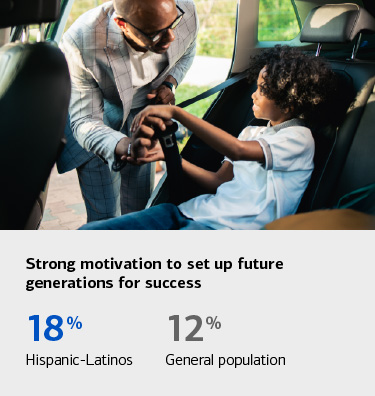
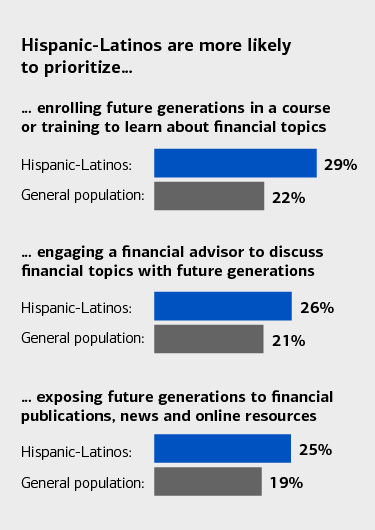
Affluent Hispanic-Latino women are more likely than men to say that parents or family are the most responsible for educating the next generation, 49% compared to 40% of Hispanic-Latino men. But they are also more likely to not know where to start, 22% versus 15% of Hispanic-Latino men.
What we learned
The widespread financial optimism and strong generational focus on family has resulted in a highly cohesive and supportive affluent Hispanic-Latino community. Despite lingering financial challenges and barriers to success, a commitment to the value of hard work and instilling that value in future generations bodes well for the continued growth and success of the Hispanic-Latino community.
At Merrill, we value our many differences and are confident we grow stronger when we connect diverse backgrounds and perspectives to better meet the needs of our teammates, our clients and our communities. Words matter but actions speak louder. To that end, we remain committed to actively supporting each of our Hispanic-Latino clients and proactively investing in the neighborhoods where you live and work.
If you have questions or would like additional information about this research, please talk with your Merrill Private Wealth Advisor.
About this research
Our 2023 study conducted in conjunction with Ipsos, a global market research and consulting firm, includes the input of thousands of affluent individuals with investable assets of $100,000+ across the Hispanic-Latino community. It’s part of a larger body of research devoted to furthering our understanding of the diverse experiences and financial paths of the communities in which we live and work, and exploring how our cultural, racial, gender, and sexual identities influence our perspectives on wealth, money and success.
A private wealth advisor can help you get started.
Read and Share
1 U.S. Census Bureau, 2022 American Community Survey.
2 Latino Donor Collaborative, 2023
Ipsos is one of the world’s largest market research companies, present in 90 markets and employing nearly 20,000 people. Merrill or any of its affiliates are not affiliated with Ipsos. In partnership with Merrill, Ipsos conducted multiple waves of research from 2019 to 2023, employing a variety of research methodologies, starting out by interviewing Merrill stakeholders who serve and represent the diverse communities. In parallel, they synthesized and reviewed an array of publications and academic research on the topics of diversity, wealth and inclusion in financial services and beyond.
The most recent Quantitative research was conducted from February 2023 to March 2023. We surveyed 500 members of each of the three communities (affluent Black/African American, affluent Hispanic-Latino and affluent LGBTQ+) and compared them to a representative sample of the n=1000 respondents from the affluent general population.